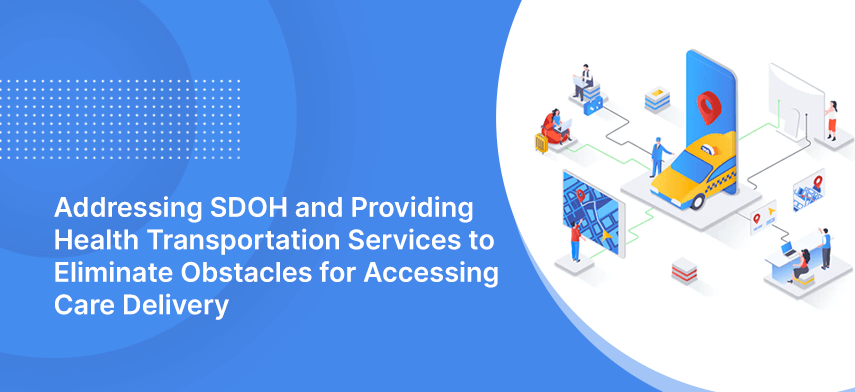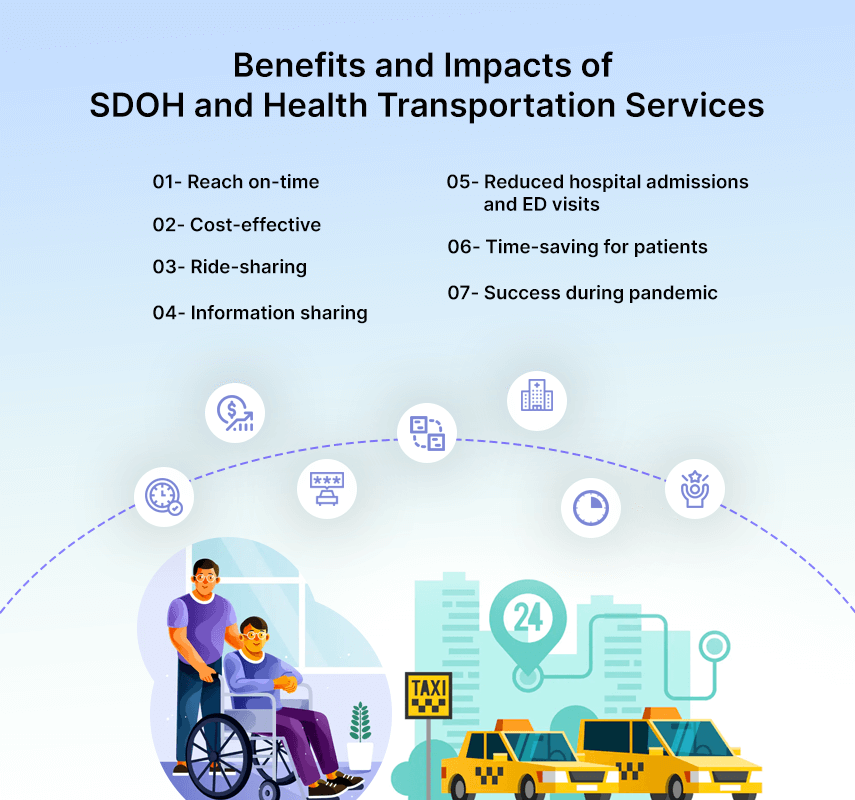The non-emergency transportation service by SDOH has helped the patients to overcome the transportation issue while reaching the health care centers for medical support. It has been so painful for the chronically ill and senior patients to wait for public transport to reach health centers. Statistics say that millions of people fail to do medical treatment on-time due to the lack of proper transportation. And that causes no-shows which cost millions of dollars. A study says that the no-shows of doctor’s appointments can cost around $28 million in a year. SDOHs medical care transportation has made this process easier as the cabs are going to provide door-to-door service for medical purposes. The NEMT service gives you the comfort to reach the medical center on-time and get hassle-free treatment.

Patient Transport Services Altering Patient Experiences
People who live in rural areas do not have access to adequate public transport services. They travel long distances to reach the urban spaces. When a patient is in critical condition and requires medical assistance, waiting for public transportation to reach a hospital becomes risky. Those residing in cities and urban spaces are experiencing high traffic, creating significant problems for the chronically ill and senior population. Hence, Social determinants of health transportation solutions have become essential for people to receive on-time medical care.
The COVID-19 spread rapidly on a global scale resulting in countries experiencing home-quarantine and complete lockdown. Billions of people suffered from getting transport services during this pandemic. Due to inadequate transportation services, many lost their lives due to COVID-19.
Access care transportation and patient care transportation with support from SDOH is making things uncomplicated for emergencies and non-emergencies.
How does Non-Emergency Medical Transportation Operate?
NEMT is a part of community health and social services where the health care centers collaborate with cab companies. Once the patient asks the center for some care or treatment, the center understands the problem first, and based on the criticality of the patient, they provide a cab or driver. The cab picks them up from their doorstep and drops them back after treatment. They track the rides on a real-time basis ensuring that the patient doesn’t experience harassment by the cab drivers. The organizations offering specialized medical care transportation services include vehicles with wheelchair accessibility, door-to-door transportation service, stretcher service, ambulances for non-emergency medical purposes, and more.
SDOH and health ride companies are going for a partnership to serve the people with non-emergency medical transportation services even during the COVID-19 pandemic.
The access care transportation targets senior citizens of the country so that they can live a healthy, and active social lifestyle. The payers and providers are focusing on NEMT services with higher technology and in a cost-effective way.
In this new health transportation service, the organization first understands the level of severity of the patient. Judging by the patient’s words they decide what types of NEMT services are required. Does the patient require a wheelchair accessible vehicle or not. If the patient has severe conditions, the requirement is for an ambulance with medical assistance. Once that is set, the vehicle will reach the patient’s doorstep to pick him up at the health center. Sometimes providers book shared vehicles for patients with less critical symptoms to save both time and cost.
Addressing SDOH has become clear to patients who are getting medical care on-time than it was before. As per statistics, it is found that 3.6 million people in the US fail to get proper medical care due to lack of proper transportation. But, the social determinant of health transportation solutions has provided remarkably during this pandemic to pick-up patients from their home to the medical center and drop them back after treatment, respectively.
The vehicle drivers and assistants are well-trained on how to take care of the patients and assist them during the transportation process. Therefore, the patients get comfortable while traveling to the health center. NEMT services are offering members under Medicare Advantage to visit places like the medicine shops, grocery stores, fitness centers, etc. while traveling back home from the health center.
Benefits and Impacts of SDOH and Health Transportation Services

The new health transportation services of SDOH are receiving excellent response from the patients, families, and staff. This feedback is creating massive data that can be used for further improvement of the process. If the response is coming continuously, then it is obvious that SDOH will keep growing and expanding its limits.
Reach on-time
Before the NEMT process, the patients experienced a longer wait time to reach the health center using public transport. Patients with serious conditions had to wait for 90 minutes on average to get an ambulance service which sometimes led to life-threatening situations. With the medical care transportation service, the waiting time is now reduced to 7 minutes for pick-up.
Cost-effective
The increased NEMT system has helped the health systems to reduce their cost by 73% on the ambulance services. The reason is due to patient transport services, people are getting medical care on-time. So, there are lesser emergency cases that need ambulatory services.
Ride-sharing
As mentioned earlier, when there are patients with mild medical conditions, the health centers offer shared cabs for them so that more than one patient can reach the health center on time. The patients are also quick to adapt to the shared ride program, therefore, the number of patients transported has increased rapidly.
Information sharing
The health centers share information about patients that helps them understand how to use and go through this system so that both the time and cost can be saved. Once the patient adopts the process completely, there will be more patients who will get proper medical care on-time every day.
Reduced hospital admissions and ED visits
With the introduction of non-emergency medical transportation services, the number of bed availability has increased, and similarly the number of no-shows, rescheduling of appointments, and emergency cases have decreased. It is counted that due to the fluency of patient transportation services, the emergency cases have reduced 50% than before.
Time-saving for patients
NEMT saves precious time for the patients and their families. Now, they do not wait for hours for the local public transportation to reach the health care centers.
Success during pandemic
During the pandemic, the SDOH program has become a great success. Millions of people have received this service and reached the health care center on-time. The door-to-door service helped the patients with other difficulties than COVID in receiving proper treatment.
These are the benefits and impact of health transportation services. The feedback from the patients is being stored as a data center which will be useful in the future for the betterment of the health system. This service is helping the health organizations target more cost-effective methods, such as the ambulatory service, which has decreased by 50% from before. The organizations have trained the SDOH assistants about how to assist the patient in medical processes like stopping at the medicine shop, verifying whether the medical insurance of the patient covers non-medical transportation, etc.
Final Thoughts,
Health transportation services have brought a huge change in the medical world by removing the barrier of transportation problems for the patients. During the COVID-19 pandemic, the situation was worse and people were worried about how to reach the health centers if they needed medical assistance, due to the global lockdown. But NEMT service and patient transportation services have made this process easy. There are different types of NEMT service that helps the SDOH to reach all communities throughout the country. These services include stretcher transportation, wheelchair transportation, door to door transportation, curb to curb transportation, and long-distance NEMT services.
As the transportation barrier is higher in urban areas with higher populations, the health care centers in these areas are required to create social determinants of health by adding NEMT services as a part of it. The availability of NEMT services in a highly-populated area increases the chance for patients to receive faster medical support. The vehicle sharing for patients with mild conditions is also a great idea to drive more patients towards better care and health access. NEMT reduces the pressure on the ambulances, therefore, the patients who are actually in need of ambulatory service get an ambulance without waiting. As the technology evolves, the transportation services will keep evolving and will be able to serve more people to save their time and money for receiving proper medical care on time.
Author's Bio


